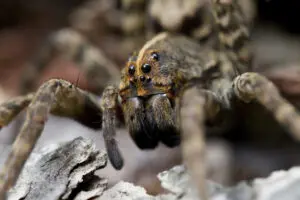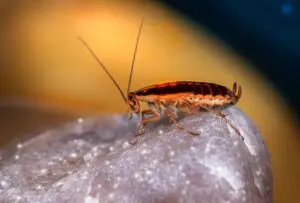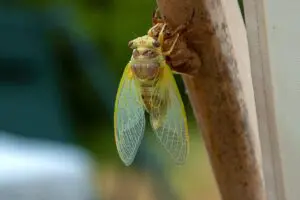
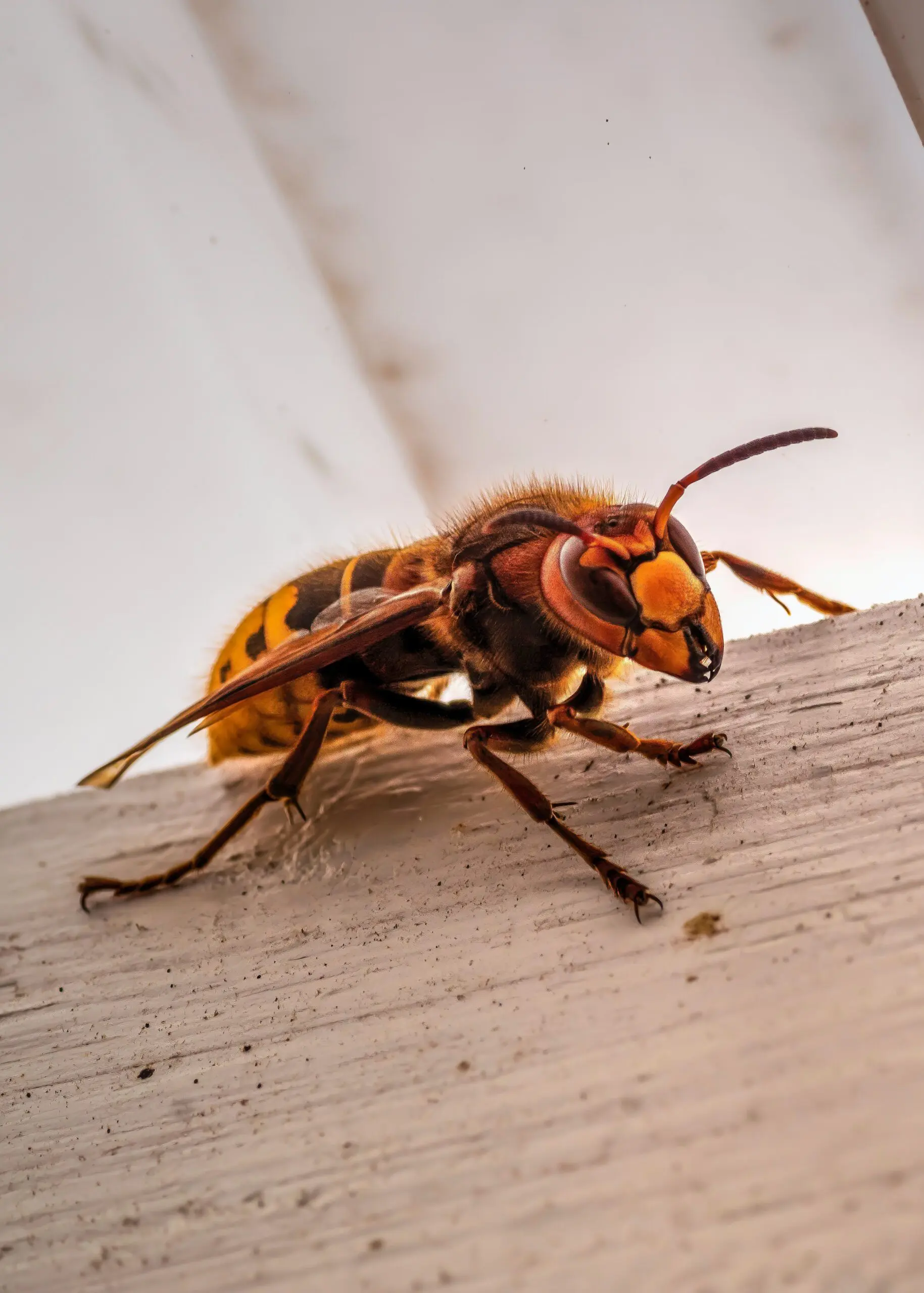
Articles and news stories about so-called “murder hornets” have been popping up left right and center. So, what are these creatures, exactly? Given their nick-name, one can only assume that they are not to be taken lightly, but are they a true cause for concern?
The possibility of these pests moving into North America has raised a number of important questions, so we did some digging and here’s what we found.
What are murder hornets?
Asian giant hornets, also known as murder hornets, are the world’s largest hornet species. Vespa mandarinia, as they are scientifically named, are native to Asia, and are most commonly witnessed in certain parts of Japan, China, and India. The queens of this species can grow to be around 2 inches in length with a 3 inch wingspan. Workers are generally about 1 ½ inches in length. Unlike males, females have stingers. Their stingers are roughly ¼ inch long and can penetrate most beekeeping equipment.
When it comes to color, this tends to vary, but typically their heads are yellowish-orange, their midsections are solid black or dark brown, and their back ends are black or dark brown with muted orange stripes.
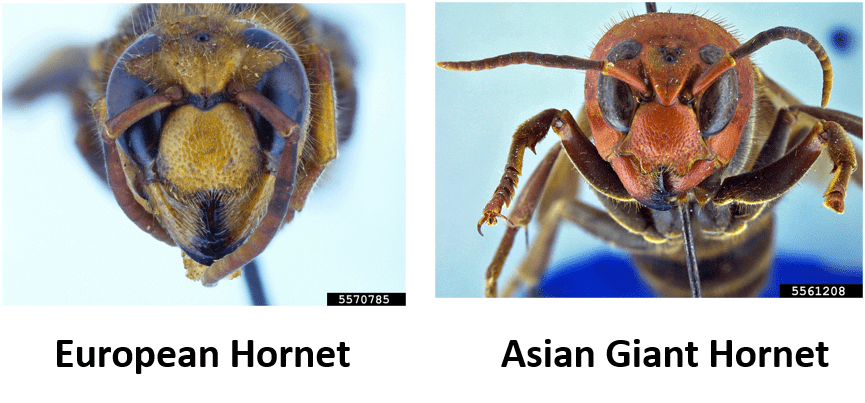
Along with their size and coloring, the heads of Asian Giant hornets make them discernible from other species.Their clypeus, which is the broad plate at the front of their head, is cleft. They also have characteristically wide genae, which are the areas below the eyes and are, more or less, the insect equivalent of cheeks. Additionally, they have orange mandibles that resemble pincers, which they use to take down their prey.
How can murder hornets be differentiated from other species?
Given their outstanding size, it seems as though Asian giant hornets would be extremely easy to identify. However, there are a number of other, more widespread species that are often mistaken for murder hornets. The most common culprit is the European hornet, as they are similar to Asian giant hornets in size and shape. Despite this, there are certain characteristics that set the two species apart, the most noticeable of which being color patterns. The abdomens of the two species are perhaps the most obvious difference.
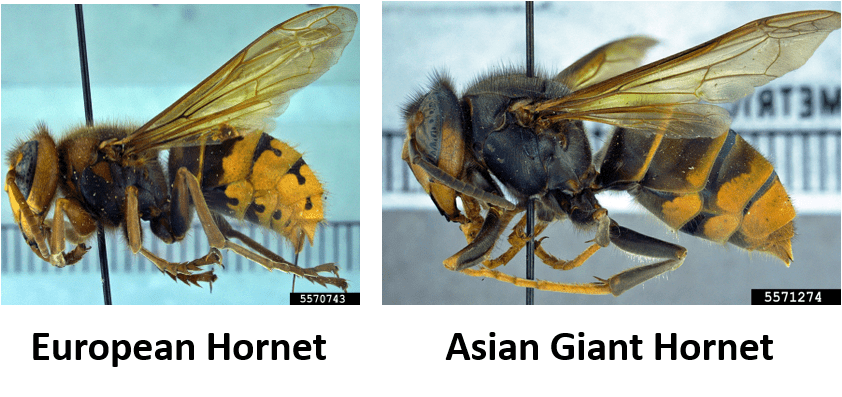
As previously mentioned, murder hornets have striped abdomens. Conversely, European hornets’ abdomens are black on the half that is attached to the thorax, and yellow on the half to which the stinger is attached. The yellow half has rows of black teardrop shapes. Additionally, the thorax of a European hornet has a combination of black and reddish-brown, rather than being all black or brown like the thorax of the Asian giant hornet.
When it comes to size, European hornets are the smaller of the two species, although not by much. Their workers average 1 inch in length and queens can be up to 1.4 inches in length. Another species that is commonly mistaken for Asian giant hornets is the Eastern cicada killer, as some grow to be up to 2 inches long. However, their colors and markings differ greatly from those of murder hornets. Eastern cicada killers are almost all black with yellow markings.
Are murder hornet stings dangerous?
Naturally, most people’s main concern regarding murder hornets is their sting. While they do not sting for no reason, they may sting if they feel threatened or if they are defending a food source.
A sting from an Asian giant hornet is undoubtedly much more painful than that of other species, but it is not usually deadly. Death or hospitalization will only occur as a result of either multiple stings or an allergic reaction to a sting. In Japan between 2000 and 2018, there was an average of 21 deaths per year from wasp, hornet, and bee stings. Only a fraction of those deaths were caused by Asian giant hornets. Meanwhile, the average number of sting-related deaths during the same time period in the U.S., where there were no murder hornets at the time, was higher, according to this graph from the CDC.
The venom from murder hornets is not as potent as that of some other species. That being said, they are larger than all other species, and therefore deliver more venom per sting. The lower potency and larger dose per sting balance each other out somewhat, meaning that Asian giant hornets pose roughly the same amount of danger to humans as most other species of hornets, despite how painful their stings are.
Why are murder hornets problematic?
Being the prolific hunters that they are, Asian giant hornets pose a great threat to other insect populations. They are known to decimate colonies of wasps, hornets, yellow jackets, and bees. They prey on honey bees almost exclusively from August to October, which makes them particularly problematic for honey bee populations.
They kill bees by using their mandibles to chop off the bee’s head, abdomen, and legs. The hornet then forms the thorax into a ball of food to bring back to its colony. A single hornet probably won’t wipe out an entire hive, but two or more hornets may. Once a hornet finds a nest to attack, it will excrete a pheromone onto the nest. This pheromone attracts the hornet’s nest mates to the target nest where they begin their invasion, called the slaughter phase. Anywhere from 2 to 50 hornets will take part in this phase, which can last between 1 and 6 hours. After an attack, the hornets will occupy and defend the honey bees’ nest for around 10 days, harvesting the dead bees and their offspring.
Japanese honey bees co-evolved with Asian giant hornets and have therefore developed a defense against single hornet attacks. North American honey bees, on the other hand, have not, which means their hives are more vulnerable. Wild honey bee hives and apiaries are both susceptible to invasions, but apiaries are more likely to be attacked. This is because wild hives are spread out, whereas apiaries have an abundance of resources all condensed into one area, which is attractive to murder hornets.
Bees are an extremely important part of the ecosystem, as they are responsible for pollinating plants and flowers. Their numbers are already declining, so the prospect of these hornets diminishing their population even more is alarming.
How did Asian Giant Hornets get to North America?
Murder hornets are native to Asia, but they have recently been spotted in both Washington, United States and British Columbia, Canada. Most sightings were of no more than a few hornets, the exception being a full nest that was found and destroyed in British Columbia (Page 21 of this research article on Vespa mandarinia contains a table of all North American sightings).
DNA tests revealed that the hornets in Washington were not related to those in British Columbia, meaning that they were probably introduced separately. Early taxonomists split Vespa mandarinia into various subspecies on the basis of different colorations depending on geographical location, though most of these subspecies are now defunct. However, this information may help to pinpoint where each of the murder hornets in North America came from.
Scientists are not sure exactly how they got here, but there are a few theories. The most likely method of arrival is accidental hitchhiking. One of the hornets may have gotten itself trapped in a shipping container on its way to North America from Asia, subsequently being released into the U.S. or Canada. Another possibility is that they were smuggled in and unintentionally freed.
The larvae and pupae of Vespa mandarinia are valued throughout Asia for their nutritional and medicinal properties, and many rural villagers rely on the income they receive from hunting and selling nests. Because of their cultural value and absence in North America, it is not unheard of for Asian giant hornet nests to be smuggled into countries like the U.S. and Canada, despite it being illegal. The larvae and pupae are kept alive until they are to be consumed, so any nests smuggled into North America are probably live. Since 2010, at least one nest of Vespa mandarinia has been intercepted at a U.S. port of entry. That being said, there is a chance that a nest which was not intercepted, or some of its residents, could have been released accidentally.
So, should we be worried about Murder Hornets?
As yet, there have been very few sightings of Asian giant hornets in North America. This means there is currently no need to panic. The chances of coming across a murder hornet are slim to none, and the chances of being stung by one are even smaller. Nonetheless, it is still unclear whether or not the individual hornets spotted in Washington and British Columbia were lone hitchhikers or members of established colonies. Given that there have only been a few sightings, it is unlikely that there is much of a population at this time. On the other hand, the fact that all of the sightings happened during a short time could potentially be a preliminary sign of an invasion. However, even if it is an indication, it is still early enough to stop the invasion before it starts.
All in all, murder hornets are not currently something to panic about. Scientists are working hard to find and eradicate all Asian giant hornets in the United States and Canada, which means, thankfully, that they will probably not become a lasting problem for us.
Still want to learn more - read on at our European Hornets FAQ page.
If you need help, give us a call for comprehensive hornet pest control.




